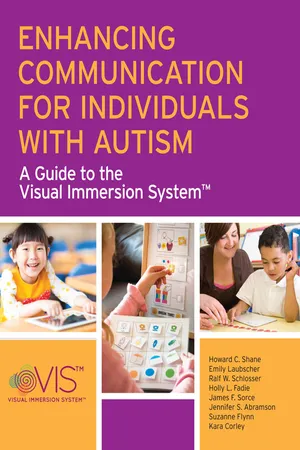
Enhancing Communication for Individuals with Autism
- 344 pages
- English
- ePUB (mobile friendly)
- Available on iOS & Android
Enhancing Communication for Individuals with Autism
About This Book
How can you help children with moderate to severe autism become more effective communicators? Discover the Visual Immersion System (VIS), a practical, research-based intervention framework that taps into the strong visual processing skills many children on the spectrum have. You'll learn how to use readily available resources—from photos and symbols to apps and software—to create a customized system of visual supports that boost seven key communicative functions (see sidebar). For each of the functions, you'll get comprehensive how-to guidance on choosing tools and materials, conducting systematic instruction, collecting data, and assessing how well interventions are working. A must for SLPs, interventionists, and educators, the innovative VIS approach will ensure better communication and higher quality of life for children with autism. WHY THE VIS WORKS:
- Uses visual supports, an approach that's proven successful for children with autism
- Strengthens communication skills needed for learning and meaningful human interaction
- Builds on evidence-based assessment and intervention procedures developed over decades at Boston Children's Hospital
- Incorporates a wide range of low-tech and higher-tech options
- Flexible—can be used in home, school, or community settings
- Provides clear, easy-to-use instructions on conducting interventions
- Includes guidance on generalizing new communication skills
PRACTICAL MATERIALS: Detailed guide to low- and higher-tech visual supports (includes benefits and limitations of each); case examples from clinical practice and field study; 15 reproducible checklists and forms to guide assessment, implementation, and progress monitoring. Help children with autism improve key communication skills:
- Protest and refusal
- Organization & transitions
- Requesting
- Directives
- Commenting
- Questions
- Social pragmatics
Frequently asked questions
Information
Table of contents
- Cover
- Title Page
- Copyright Page
- Contents
- List of Figures
- List of Tables
- About the Downloadable Material
- Contents of the Downloadable Files
- About the Authors
- Foreword Connie Kasari
- Preface
- Acknowledgments
- 1. An Overview of the Visual Immersion System™
- 2. Language Acquisition and Symbolic Competence
- 3. Tools Used to Support Visual Language and Communication
- 4. Principles of Assessment
- 5. Principles of Intervention
- 6. Protesting
- 7. Organization and Transitions
- 8. Requesting
- 9. Directives
- 10. Commenting
- 11. Questions
- 12. Social Pragmatics
- References
- Index